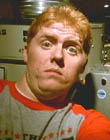|
|
This topic comprises 2 pages: 1 2
|
|
Author
|
Topic: NEED HELP : Projectionists 101
|
|
|
|
|
|
|
|
|
|
|
|
|
|
|
|
|
|
|
|
|
|
|
|
|
|
|
|
|
Frank Angel
Film God

Posts: 5305
From: Brooklyn NY USA
Registered: Dec 1999
|
 posted 03-30-2007 10:07 AM
posted 03-30-2007 10:07 AM





Brenda, if this is a real post -- and it certainly can be given how exhibitors run theatres now-a-days, you need to tell SOMEONE, preferably your supervisor or manager that you simply do not have the knowledge to run the projection booth. You can't fake this. Someone who has worked that booth with some modicum of competence needs to show you things that we can't possibly know because they are unique to that booth, like the masking control switches (which sounds like this could be one of the issues) lighting controls, etc. No one should be thrown into a booth without the operator before him/her running through the booth controls.
Is there anyone besides you who runs this booth and runs it without showing the movie on the theatre walls? If so, find this person and get a quick tour of the ins and outs. Certain quirks of a booth operation could baffle even the most competent projectionist -- the booth lights needing to be turned on by a panel in the manager's office, for example -- actually happend to me; the aperture plates being kept in a draw hidden below the rewind table, etc. Sometimes a simple word from someone who has worked the booth can save you hours of searching and hair-pulling.
That being said, the FT guys, as you can see have already tried to unravel the possibilities for you. But there is more information that we need to know.
1) is the theatre set up so that when the different types of movies are shown, usually referred to as Scope and flat., the Scope image is a much wider than it is high, while the Flat image is the same height as the Scope, only not as wide? OR -- is it set up so that no matter what type of picture is being shown, Scope or Flat, both are the same width, but one shrinks from top to bottom so that it is the same width as the other, but not as tall.
2) is it clear that there are only two sets of lenses -- Scope and Flat? Usually you can tell which is which -- the Scope is usually larger and if you can look into the lens, nothing looks round, it looks oval and curved; the Flat lens everything looks normal -- not oval or distorted. If your theatre runs other than first run, there may be additional lenses that will have to be investigated.
3) do you find aperture plates in the booth as well? These are metal plates about 2 inches by 1 inch with a handle on one end and either a squarish hole in the metal or a rectangular hole about the same size as a film frame. How many of these do you find near the projector? Do you find only two -- one in which the hole is an obvious rectangular shape and the other has a hole that is square shaped. You should likely find markings on either punched somewhere in the metal near the handle or even hand written on the handle itself that would say 2.35 or 2.39 (that would be for the Scope features) and the other would have 1.85 or some other number. Making things more complicated, they may both have the same number, something like 2.1 but the holes will still be shaped differently. If you can find these plates, we need to know what is marked on them and better, what they look like. Do you have any kind of digital camera that you could take pictures of this and other items in the booth that the FTers here could ask to see? -- that would be of great help. If there are only two plates and two lenses, then it will be a piece of cake to determine which goes with what lens and how to set the mask to match which format is being projected.
Which leads me to as an obvious question, but from what you say, we need to ignore what may be obvious here and ask everything. When you change lenses, are you also changing aperture plates -- the metal things with the little handles (for the Simplex). The plates are essential to stopping parts of the image from being projected taller or sometimes wider than the screen. If you do not put in any plate at all, the image will, as you describe, be all over the walls. The aperture plate prevents this.
Tell us more. We might even be able to get it right from this end, but it certainly would be easier if you found someone who worked the booth (and isn't a jerk with an attitude) to show you where the aperture plates are, what lenses to use and how to change the masks. You probably should also know what all the switches do. The unmarked ones may very well be controlling something that was customized for that booth but were never etched or marked. And damn them for throwing you into the booth without so much as a cursory run thru on it's operation.
And just a word of wisdom -- remember this whenever you get "attitude" from someone -- people with attitudes usually have those attitudes because they are insecure and don't actually have an answer to what you are asking in the first place -- attitude is an insecure jerk's cover for lack of knowledge.
Best of luck Brenda -- not to despair....you got the film threaded correctly and the picture focused and I assume you've got sound going....that's a good start. ![[thumbsup]](graemlins/thumbsup.gif) We'll continue to help where we can, but if you can take pictures, that would go a long way to letting us help you. Especially pictures of what the picture looks like in the auditorium on the walls and such would be very helpful. We'll continue to help where we can, but if you can take pictures, that would go a long way to letting us help you. Especially pictures of what the picture looks like in the auditorium on the walls and such would be very helpful.
| IP: Logged
|
|
|
|
All times are Central (GMT -6:00)
|
This topic comprises 2 pages: 1 2
|
Powered by Infopop Corporation
UBB.classicTM
6.3.1.2
The Film-Tech Forums are designed for various members related to the cinema industry to express their opinions, viewpoints and testimonials on various products, services and events based upon speculation, personal knowledge and factual information through use, therefore all views represented here allow no liability upon the publishers of this web site and the owners of said views assume no liability for any ill will resulting from these postings. The posts made here are for educational as well as entertainment purposes and as such anyone viewing this portion of the website must accept these views as statements of the author of that opinion
and agrees to release the authors from any and all liability.
|

 Home
Home
 Products
Products
 Store
Store
 Forum
Forum
 Warehouse
Warehouse
 Contact Us
Contact Us




 Printer-friendly view of this topic
Printer-friendly view of this topic






![[Smile]](smile.gif)
![[Razz]](tongue.gif)








![[Frown]](frown.gif) If Tennessee were still in my sales territory, I would stop by and help her.
If Tennessee were still in my sales territory, I would stop by and help her.

![[thumbsup]](graemlins/thumbsup.gif) We'll continue to help where we can, but if you can take pictures, that would go a long way to letting us help you. Especially pictures of what the picture looks like in the auditorium on the walls and such would be very helpful.
We'll continue to help where we can, but if you can take pictures, that would go a long way to letting us help you. Especially pictures of what the picture looks like in the auditorium on the walls and such would be very helpful.



